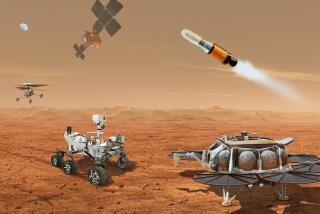NASA on the Wrong Trajectory
On Thursday the space shuttle will catapult into orbit the second load of components of the world’s most ambitious building project to date: the International Space Station. NASA is trying to portray the launching as another step in an inevitable progression toward a manned space facility the size of two 747 jetliner cabins. Congress, however, should instead view the project as a work in progress, because escalating problems show that NASA’s current plans may well need revision.
The station was first pitched to President Ronald Reagan as an $8-billion voyage into space that could be completed by 1992, just in time to commemorate the 500th anniversary of Christopher Columbus’ voyage to the New World. The latest cost estimate from the Government Accounting Office has soared to $96 billion and the completion date has been bumped to 2004.
To avoid more cost overruns, Congress should consider downsizing the project in ways that NASA has deemed feasible--by, for instance, replacing the planned living module with a “TransHab,” a more flexible module that could double as the living quarters on a future mission to Mars.
A space station of the gargantuan proportions that NASA proposes simply doesn’t make sense given NASA’s shaky scientific rationale for the project. About the best the agency can do is claim “It’s going to benefit humankind . . . in ways we don’t [yet] know.”
That’s not enough, especially when leading space scientists contend that space research and exploration can be done far more effectively and less expensively with unmanned robotic craft like NASA’s Clementine probe, which explored the moon (and found evidence of ice near the surface) for a mere $75 million. Clementine is a sign that NASA can be, as the agency has promised Congress, “faster, better and cheaper.”
The space station project, in contrast, exemplifies the old, Cold-War NASA: Its government-protected monopolies have often thwarted innovation on new propulsion systems, and its decisions have often been driven by the foreign policy concerns of the State Department, as in the “partnership” with Russia. Instead of paying its way, Russia has asked the United States for $660 million to build its parts of the space station.
Despite its visionary-sounding rhetoric, NASA will need the help of Congress to find a way past old thinking and toward an economically and scientifically sensible vision of the future.
More to Read
Sign up for Essential California
The most important California stories and recommendations in your inbox every morning.
You may occasionally receive promotional content from the Los Angeles Times.










